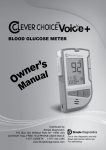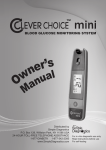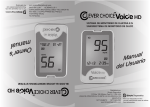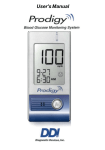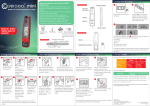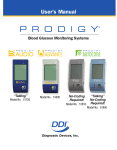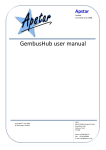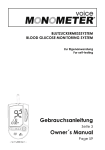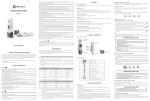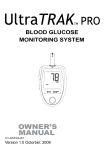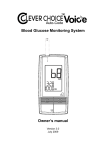Download Clever Choice Auto-Code Pro Owner`s manual
Transcript
’s r e n al w O anu M Distributed by Simple Diagnostics P.O. Box 128, Williston Park, NY 11596 USA 24-HOUR TOLL-FREE TELEPHONE ASSISTANCE 1-877-DIABETK 1-877-342-2385 www.SimpleDiagnostics.com For in vitro diagnostic use only Read instructions before use For self-testing Blood Glucose Monitoring System OWNER'S MANUAL Dec. 2009 Version 1.0 311-4267100-001 Dear CLEVER CHOICE Auto-Code Pro’s System Owner: Thank you for purchasing the CLEVER CHOICE Auto-Code Pro Blood Glucose Monitoring System. This manual provides important information to help you to use the system properly. Before using this product, please read the following contents thoroughly and carefully. Regular monitoring of your blood glucose levels can help you and your doctor gain better control of your diabetes. Due to its compact size and easy operation, you can use the CLEVER CHOICE AutoCode Pro Blood Glucose Monitoring System to easily monitor your blood glucose levels by yourself anywhere, any time. If you have other questions regarding this product, please contact the place of purchase, or call our 24-hour toll free number 1-877DIABETK (1-877-342-2385). IMPORTANT SAFETY PRECAUTIONS READ BEFORE USE 1. Use this device ONLY for the intended use described in this manual. 2. Do NOT use accessories which are not specified by the manufacturer. 3. Do NOT use the device if it is not working properly or or if it is damaged. 4. Do NOT use the equipment in places where aerosol sprays are being used, or where oxygen is being administered. 5. Do NOT under any circumstances use the device on newborns, infants, or people who cannot communicate. 6. This device does NOT serve as a cure for any symptoms or diseases. The data measured is for reference only. Always consult your doctor to have the results interpreted. 7. Before using this device to test blood glucose, read all instructions thoroughly and practice the test. Carry out all the quality control checks as directed. 8. Keep the device and testing equipment away from young children. Small items such as the battery cover, batteries, test strips, lancets and vial caps are choking hazards. 9. Use of this instrument in a dry environment, especially if synthetic materials are present (synthetic clothing, carpets etc.) may cause damaging static discharges that may cause erroneous results. 10. Do not use this instrument in close proximity to sources of strong electromagnetic radiation, as these may interfere with the proper operation. KEEP THESE INSTRUCTIONS IN A SAFE PLACE TABLE OF CONTENTS IMPORTANT SAFETY PRECAUTIONS 5 BEFORE YOU BEGIN 8 Important Information 8 Intended Use 9 Test Principle 9 Contents of System 10 Meter Overview 11 Screen Display 12 Test Strip 13 Setting the Meter 14 THE FOUR MEASURING MODES 18 CONTROL SOLUTION TESTING 19 Performing a Control Solution Test TESTING WITH BLOOD SAMPLE 19 22 Overview of the Lancing Device 22 Setting up the lancing device 23 Preparing the puncture site 24 Alternative Site Testing 26 Performing a blood glucose test 28 METER MEMORY 31 Reviewing Test Results 31 Reviewing Blood Glucose Day Average Results 32 DOWNLOADING RESULTS ONTO A COMPUTER 34 MAINTENANCE 35 Battery 35 Caring for Your Meter 37 Caring for Your Test Strips 37 Important Control Solution Information 38 SYSTEM TROUBLESHOOTING 39 Result Readings 39 Error Messages 40 Troubleshooting 41 DETAILED INFORMATION 42 Reference values 42 Comparing Meter and Laboratory Results 43 SPECIFICATIONS 45 BEFORE YOU BEGIN Important Information Severe dehydration and excessive water loss may cause readings which are lower than actual values. If you believe you are suffering from severe dehydration, consult a healthcare professional immediately. If your blood glucose results are lower or higher than usual, and you do not have symptoms of illness, first repeat the test. If you have symptoms or continue to get results which are higher or lower than usual, follow the treatment advice of your healthcare professional. Use only fresh whole blood samples to test your blood glucose. Using other substances will lead to inaccurate results. If you are experiencing symptoms that are inconsistent with your blood glucose test results and you have followed all the instructions given in this owner’s manual, contact your healthcare professional. Inaccurate results may occur in severely hypotensive individuals or patients who are in shock. Readings which are lower than actual values may occur for individuals in a hyperglycemic-hyperosmolar state, with or without ketosis. Please consult your healthcare professional before use. 8 Intended Use This system is intended for use outside the body (in vitro diagnostic use) by people with diabetes at home and by health care professionals in clinical settings as an aid to monitoring the effectiveness of diabetes control. It is intended to be used for the quantitative measurement of glucose (sugar) in fresh whole blood samples (from the finger, palm, forearm, upper arm, calf and thigh). It should not be used for the diagnosis of diabetes, or testing on neonates. Test Principle Your system measures the amount of sugar (glucose) in whole blood. The glucose testing is based on the measurement of electrical current generated by the reaction of glucose with the reagent of the strip. Your meter measures the current, calculates the blood glucose level, and displays the result. The strength of the current produced by the reaction depends on the amount of glucose in the blood sample. 9 Contents of System Your new CLEVER CHOICE Auto-Code Pro system kit includes: Meter Daily Log Book Owner’s Manual Warranty Card Storage case Sterile Lancets Quick Start User Guide One CR2032 Battery Quick Start User Guide Test strip and control solution are not included in the kit (please check the contents on your product box). They can be purchased separately. Please make sure you have those items needed for a blood glucose test beforehand. NOTE If any items are missing from your kit or opened prior to use, please contact local customer services or place of purchase for assistance. 10 Meter Overview Top Left Side Front Right Side Back Rear DISPLAY SCREEN BATTERY COMPARTMENT M BUTTON Enter the meter memory and silence a reminder alarm. TEST STRIP EJECTOR TEST SLOT Insert test strip here to turn the meter on for testing. DATA PORT Download test results with a cable connection. Eject the used strip by pushing up this button. UP BUTTON & TON DOWN BUT- Select or change information. S BUTTON Enter and confirm the meter settings. 11 Screen Display 12 Measurement mode Day average Blood drop symbol Low battery symbol Test strip symbol Memory symbol Error message Ketone warning Test result Control solution mode Date Measurement unit Time Reminder alarms Test Strip Absorbent Hole Apply a drop of blood here and the blood will be drawn in automatically. Confirmation window Confirm if enough blood has been applied to the absorbent hole of the test strip. Test Strip Handle Hold this part to insert the test strip into the slot. Contact Bars Insert this end of the test strip into the test slot. Attention! Test results might be wrong if the contact bar is not fully inserted into the test slot. The front side of the test strip should face up when inserting the test strip. Front Back NOTE The CLEVER CHOICE Auto-Code Pro meter should only be used with CLEVER CHOICE Auto-Code Pro Test Strips. Using other test strips with this meter can produce inaccurate results. 13 Setting the Meter Before using your meter for the first time or if you change the meter battery, you should check and update these settings. Make sure you complete the steps below and have your desired settings saved. Entering the setting mode Start with the meter off (no test strip inserted). Press and firmly hold for 3 seconds until the meter turns on. 1. Setting the date With the year flashing, press rect year appears. Press . or or With the month flashing, press rect month appears. Press . With the day flashing, press day appears. Press . 14 or until the cor- until the cor- until the correct 2. Setting the time format Press and release 24h. Press . or to select the desired time format --- 12h or 3. Setting the time With the hour flashing, press rect hour appears. Press . With the minute flashing, press rect minute appears. Press . or until the cor- or until the cor- 4. Deleting the Memory With “dEL” and a blinking “ ” symbol on the display, press and select “no” to keep the results in memory. 15 If you would like to delete ALL the results, press or and select “Yes” then press to confirm. “OK” and “ ” are displayed on the meter, which indicates that all data stored is deleted. 5. Setting the Reminder Alarm You may set up any or all of the reminder alarms (1-4). The meter , press or to turn on or turn off to displays “On” or “OFF” and set the first reminder alarm. Press or to select “On”, then press to set the hour. When the hour is flashing, press or to add an hour. Press to confirm and go to minutes, press or to add one minute. Press to confirm and go to the next alarm setting. 16 If you do not want to set an alarm, press to skip this step. If you want to turn off an alarm, find the alarm number by pressing in the setting mode, press or to change from “ON’ to “OFF”. At the time of your alarm, the meter will beep and automatically turn on. You can press to silence the alarm and insert a test strip to begin testing. If you do not press , the meter will beep for 2 minutes then switch off. If you do not want to test at this time, press to switch off the meter. Congratulations! You have completed all settings! NOTE These parameters can ONLY be changed in the setting mode. If the meter is idle for 3 minutes during the setting mode, it will switch off automatically. 17 THE FOUR MEASURING MODES The meter provides you with four modes for measuring General, AC, PC and QC. Modes Use when General (displays as “Gen”) any time of day without regard to time since last meal AC no food intake for at least 8 hours PC 2 hours after a meal QC testing with the control solution You can switch between each mode by: 1. Start with the meter switched off. Insert a test strip to turn on the meter, the screen will display flashing blood drop and “Gen”. 2. Press M to switch between General, AC, PC and QC. 18 CONTROL SOLUTION TESTING CLEVER CHOICE Control Solution contains a known amount of glucose that reacts with test strips and is used to ensure your meter and test strips are working together properly. Do a control solution test when: you first receive the meter, at least once a week to routinely check the meter and test strips, you begin using a new vial of test strips, you suspect the meter or test strips are not working properly, your blood glucose test results are not consistent with how you feel, or if you think the results are not accurate, practicing the testing process, or you dropped or think you have damaged the meter. Performing a Control Solution Test 1. Insert the test strip to turn on the meter Insert the test strip into the meter. Wait for the meter to display the test strip and blood drop symbol. 19 2. Press tion test to mark this test as a control solu- With “QC” displays, the meter will not store your test result in memory. If you press again, the “QC” will disappear and this test is no longer a control solution test. WARNING When doing the control solution test, you have to mark it so that the test result will not be stored in the memory. Failure to do so will mix up the blood glucose test results with the control solution test results in memory. 3. Apply Control Solution Shake the control solution vial thoroughly before use. Squeeze out a drop and wipe it off, then squeeze another drop and place it on the tip of the vial cap. Hold the meter to move the absorbent hole of test strip to touch the drop. Once the confirmation window fills completely, the meter will begin counting down. To avoid contaminating the control solution, do not directly apply control solution onto a strip. 20 4. Read and Compare the Result After counting down to 0, the test result of control solution will appear on the display. Compare this result with the range printed on the test strip vial and it should fall within this range. If not, please read instructions again and repeat the control solution test. Normal 109~165 Out-of-range results If you continue to have test results fall outside the range printed on the test strip vial, the meter and strips may not be working properly. Do NOT test your blood. Contact the local customer service or place of purchase for help. NOTE The control solution range printed on the test strip vial is for control solution use only. It is not a recommended range for your blood glucose level. See the Maintenance section for important information about your control solutions. 21 TESTING WITH BLOOD SAMPLE Overview of the Lancing Device Lancet Holder Cocking Control Release Button Depth Indicator 3 4 5 A Clear Cap Arrow Adjustable Tip If your lancing device differs from the one shown here, please refer to the manufacturer’s manual to ensure proper usage. NOTE To reduce the chance of infection: Never share a lancet or the lancing device. Always use a new, sterile lancet. Lancets are for single use only. Avoid getting hand lotion, oils, dirt, or debris in or on the lancets and the lancing device. 22 Setting Up the Lancing Device Screw off the cap of the lancing device. Insert a lancet into the lancet holder and push down firmly until it is fully in place. Twist the protective disk until it separates from the lancet. 4 5 23 Replace the lancing device cap. Turn the cap until it is snug but not too tight. The adjustable tip offers 5 levels of skin penetration. Twist the adjustable tip in either direction until the number lines up with the arrow: 1-2 for soft or thin skin, 23 4 3 for average skin, 5 Slide the cocking control back until it clicks. If it does not click the device may have been cocked when the lancet was inserted. 23 4 5 4-5 for thick or calloused skin. The lancing device is now ready for use. Set aside for later use. 23 Preparing the Puncture Site Stimulating blood perfusion by rubbing the puncture site prior to blood extraction has a significant influence on the glucose value obtained. Blood from a site that has not been rubbed exhibits a measurably different glucose concentration than blood from the finger. When the puncture site was rubbed prior to blood extraction, the difference was significantly reduced. Please follow the suggestions below before obtaining a drop of blood: Rub the puncture site for about 20 seconds before penetration. Use a clear cap (included in the kit) while setting the lancing device. Wash and dry your hands before starting. Select the puncture site either at the fingertips or another body part (please see section “Alternative Site Testing”(AST) on how to select the appropriate sites). Clean the puncture site using cotton moistened with 70% alcohol and let it air dry. 24 23 4 5 Fingertip testing Hold the lancing device firmly against the side of your finger. Press the release button. You will hear a click, indicating that the puncture is complete. Blood from sites other than the fingertip A clear cap, together with the kit, makes it easier to get a drop of blood for AST. When you want to obtain blood from sites other than the finger, replace the lancing device cap with the clear cap. Turn the clear cap until it is snug but not too tight, and then slide the cocking control back until it clicks. NOTE Choose a different spot each time you test. Repeated punctures at the same spot may cause soreness and calluses. Please consult your health care professional before you begin AST. It is recommended to discard the first drop of blood as it might contain tissue fluid, which may affect the test result. 25 Alternative Site Testing IMPORTANT: There are limitations with AST (Alternative Site Testing). Please consult your health care professional before you perform AST. What is AST? Alternative site testing (AST) means that people use parts of the body other than the fingertips to check their blood glucose levels. This system allows you to test on the palm, the forearm, the upper arm, the calf or the thigh with results equivalent to fingertip testing. What is the advantage? Fingertips feel pain more readily because they are full of nerve endings (receptors). At other body sites, since nerve endings are not so condensed, you will not feel as much pain as on the fingertips. When to use AST? Food, medication, illness, stress and exercise can affect blood glucose levels. Capillary blood at fingertip reflects these changes faster than capillary blood at other sites. Thus, when testing blood glucose during or immediately after meal, physical exercise, or any other event, take the blood sample from your finger only. 26 We strongly recommend you perform AST ONLY at the following times: In a pre-meal or fasting state (more than 2 hours since the last meal). Two hours or more after taking insulin. Two hours or more after exercise. Do NOT use AST if: You think your blood glucose is low. You are unaware of hypoglycemia You are testing for hyperglycemia Your AST results do not match the way you feel. Your routine glucose results are often fluctuating. 27 Performing a Blood Glucose Test 1. Insert the test strip to turn on the meter Wait for the meter to display the test strip and blood drop symbol. 2. Select the appropriate measurement mode by pressing For selecting the measurement mode of AC, PC, or Gen, please refer to the “THE FOUR MEASURING MODES” on page 16. 3. Obtaining a blood sample Use the prior set lancing device to puncture your desired site. After penetration, discard the first drop of blood with a clean cotton swab. Gently squeeze the punctured area to obtain another drop of blood. Be careful NOT to smear the blood sample. The volume of blood sample must be at least 0.5 microliter (μL) of volume. ( actual size). 4. Apply the Sample Hold the blood drop to touch the absorbent hole of the test strip. Blood will be drawn in and after the confirmation window is completely filled, the meter begins counting down. 28 . NOTE Do not press your puncture site against the test strip or try to smear the blood. If you do not apply a blood sample to the test strip within 3 minutes, the meter will automatically turn off. You must remove and reinsert the test strip to start a new test. The confirmation window should be filled with blood before the meter begins to count down. NEVER try to add more blood to the test strip after your drop of blood has moved away. Discard the used test strip and retest with a new one. If you have trouble filling the confirmation window, please contact your health care professional or the local customer service for assistance. 5. Read Your Result The result of your blood glucose test will appear after the meter counts down to 0. This blood glucose result will automatically be stored in the memory. 29 6. Eject the used test strip and remove the lancet To eject the test strip, point the strip at a disposal container for sharp objects. The meter will switch itself off automatically after the test strip is ejected. Always use caution when removing the lancet. Take the lancet out by hand carefully. Place the disk on a hard surface and push the exposed tip into the protective disk. WARNING The used lancet and test strip may be biohazards. Please discard them carefully according to your local regulations. 30 METER MEMORY Your meter stores 450 the most recent blood glucose test results along with respective dates and times in meter memory. To enter the meter memory, start with the meter switched off. Reviewing Test Results 1. Press and release . will appear on the display. Press again, and the first reading you see is the last blood glucose result along with date, time and the measurement mode. 2. Press to recall the test results stored in the meter each time you press. 3. Exit the meter memory After the last test result, press meter will be turned off. again and the NOTE If the meter is left idle for more than 5 seconds after entering the memory mode, the meter then will display the following message on the LCD. This indicates that you can insert a test strip and initiate a blood glucose test. 31 Reviewing Blood Glucose Day Average Results 1. Press and release When appears on the display, keep pressing for 3 seconds until the blinking “ ” appears. Release and then your 7-day average result measured in general mode will appear on the display. 2. Press to review 14-, 21-, 28-, 60- and 90- day average results stored in each measurement modes in the order of Gen, AC, then PC. For example: 32 2. Exit the meter memory Keep pressing test result. and the meter will turn off after displaying the last NOTE Any time you want to exit the memory, keep pressing for 5 seconds or leave it without any action for 3 minutes. The meter will switch off automatically. Control solution results are NOT included in the day average. If using the meter for the first time, “---“ displays when you recall the test results or review the average result. It indicates that there is no test result in memory. 33 DOWNLOADING RESULTS ONTO A COMPUTER You can use your meter with a USB cable and the Health Care Software System to view your test results on your personal computer. To learn more about the Health Care Software System or to obtain a USB cable separately, please contact local customer services or the place of purchase for assistance. 1. Obtaining the required cable and installing the software To download the Health Care Software System, please visit Simple Diagnostics website at http://www.SimpleDiagnostics.com 2. Connecting to a personal computer Connect the cable to a USB port on your computer. With the meter switched off, connect the other end of the cable to the meter data port. “PC” will appear on the meter display, indicating that the meter is in communication mode. 3. Data transmission To transmit data, follow the instructions provided with the software. Results will be transmitted with date and time. Remove the cable and the meter will automatically switch off. WARNING While the meter is connecting to the PC, it will be unable to perform a blood glucose test. 34 MAINTENANCE Battery Your meter comes with one 3V CR2032 lithium battery. Low Battery Signal The meter will display one of the messages below to alert you when the meter power is getting low. 1. The symbol appears along with display messages: The meter is functional and the result remains accurate, but it is time to change the battery. 2. The low: symbol appears with E-b, Error and The power is not enough to do a test. You must change the battery immediately. LOW Replacing the Battery To replace the battery, make sure that the meter is turned off. 1. Press the edge of the battery cover and lift it up to remove. 2. Remove the old battery and replace with one 3V CR2032 lithium battery. 3. Close the battery cover. If the battery is inserted correctly, you will hear a “beep” afterwards. 35 CR2032 CR2032 BATTERY CR2032 BATTERY BATTERY NOTE Replacing the battery does not affect the test results stored in the memory. As with all small batteries, these batteries should be kept away from small children. If swallowed, promptly seek medical assistance. Batteries might leak chemicals if unused for a long time. Remove the batteries if you are not going to use the device for an extended period (i.e. 3 months or more). Properly dispose of the batteries according to your local environmental regulations. 36 Caring for Your Meter To avoid the meter and test strips attracting dirt, dust or other contaminants, please wash and dry your hands thoroughly before use. Cleaning 1. To clean the meter exterior, wipe it with a cloth moistened with tap water or a mild cleaning agent, then dry the device with a soft and dry cloth. Do NOT flush with water. 2. Do NOT use organic solvents to clean the meter. Meter Storage Storage condition: -4°F~140°F (-20°C~60°C), below 95% relative humidity. Always store or transport the meter in its original storage case. Avoid dropping and strong impact. Avoid direct sunlight and high humidity. Caring for Your Test Strips Storage condition: 39.2°F~104°F (4°C~40°C), below 85% relative humidity. Do not freeze. Store your test strips in their original vial only. Do not transfer to other container. Store test strip packages in a cool and dry place. Keep away from direct sunlight and heat. After removing a test strip from the vial, immediately close the vial cap tightly. Touch the test strip with clean and dry hands. Use each test strip immediately after removing it from the vial. Write the opening date on strip vial label when you first opened it. Discard remaining test strips after 3 months. 37 Do not use test strips beyond the expiration date. This may cause inaccurate results. Do not bend, cut, or alter a test strip in any way. Keep the strip vial away from children since the cap and the test strip may be a choking hazard. If swallowed, promptly see a doctor for help. For further information, please refer to the test strip package insert. Important Control Solution Information Use only CLEVER CHOICE control solutions with your meter. Do not use the control solution beyond the expiration date or 3 months after first opening. Write the opening date on the control solution vial and discard the remaining solution after 3 months. It is recommended that the control solution test should be done at room temperature (68°F-77°F/20°C-25°C). Make sure your control solution, meter, and test strips are at this specified temperature range before testing. Shake the vial before use, discard the first drop of control solution, and wipe off the dispenser tip to ensure a pure sample and an accurate result. Store the control solution tightly closed at temperatures between 36°F and 86°F (2°C to 30°C). Do NOT freeze. 38 SYSTEM TROUBLESHOOTING If you follow the recommended action but the problem persists, or error messages other than the ones below appear, please call your local customer service. Do not attempt to repair by yourself and never try to disassemble the meter under any circumstances. Result Readings MESSAGE WHAT IT MEANS Appears when your result is below measurement limit, which is less than 20 mg/dL (1.1 mmol/L). This indicates hypoglycemia (low blood glucose). You should seek medical assistance immediately. Appears when your result is equal to or higher than 240 mg/dL (13.3 mmol/L). This indicates the possibility of ketone accumulation for type 1 diabetes. Please seek medical assistance immediately. Appears when your result is higher than the limit of measurement, which is higher than 600 mg/dL (33.3mmol/L). This indicates hyperglycemia. You should seek medical assistance immediately. 39 Error Messages MESSAGE WHAT DOES METER SAY? WHAT IT MEANS ACTION Battery is dead. Please replace. Appears when the batteries cannot provide enough power for a test. Replace the batteries immediately. Test strip has been used. Please replace. Appears when a used test strip is inserted Repeat the test with a new test strip. Repeat the test with a new test strip. Problem in operation. Test strip has been removed during testing. Appears when test strip is removed while counting down. Repeat the test with a new test strip. Appears when ambient temperature is below system operation range. System operation range is 10°F~40°F (50°C~104°C ). Room temperature is out of range. Thus unable to measure. 40 If the meter still does not work, please contact the customer service for assistance. System error. Appears when ambient temperature is above system operation range. Repeat the test after the meter and test strip are in the above temperature range. Troubleshooting 1. If the meter does not display a message after inserting a test strip: POSSIBLE CAUSE WHAT TO DO Battery exhausted. Replace the battery. Test strip inserted upside down or incompletely. Insert the test strip with contact bars end first and facing up. Defective meter or test strips. Please contact customer services. 2. If the test does not start after applying the sample: POSSIBLE CAUSE WHAT TO DO Insufficient blood sample. Repeat the test using a new test strip with larger volume of blood sample. Defective test strip. Repeat the test with a new test strip. Sample applied after automatically shutoff (2 minutes after last user action). Repeat the test with a new test strip. Defective meter. Please contact customer services. Apply sample only when flashing “ ” appears on the display. 3. If the control solution testing result is out of range. POSSIBLE CAUSE WHAT TO DO Error in performing the test. Read instructions thoroughly and repeat the test again. Control solution vial was poorly shaken. Shake the control solution vigorously and repeat the test again. Expired or contaminated control solution. Check the expiration date of the control solution. Control solution that is too warm or too cold. Control solution, meter, and test strips should be at room temperature (68°F-77°F/20°C-25°C) before testing. Defective test strip. Repeat the test with a new test strip. Meter malfunction. Please contact customer services. 41 DETAILED INFORMATION Reference Values Blood glucose monitoring plays an important role in diabetes control. A long-term study showed that maintaining blood glucose levels close to normal can reduce the risk of diabetes complications by up to 60%*1. The results provided by this system can help you and your healthcare professional monitor and adjust your treatment plan to gain better control of your diabetes. Time of day Normal plasma glucose range for people without diabetes (mg/dL) Fasting and before meal Less than 100 mg/dL (5.6 mmol/L) 2 hours after meals Less than 140 mg/dL (7.8 mmol/L) Source: American Diabetes Association (2008). Clinical Practice Recommendations. Diabetes Care, 31 (Supplement 1): S1-108. Please work with your doctor to determine a target range that works best for you. *1: American Diabetes Association position statement on the Diabetes Control and Complications Trial (1993). 42 Comparing Meter and Laboratory Results The meter provides you with whole blood equivalent results. The result you obtain from your meter may differ somewhat from your laboratory result due to normal variation. Meter results can be affected by factors and conditions that do not affect laboratory results in the same way. To make an accurate comparison between meter and laboratory results, follow the guidelines below. Before going to the lab: Perform a control solution test to make sure that the meter is working properly. Fast for at least eight hours before doing comparison tests, if possible. Take your meter with you to the lab. While staying at the lab: Make sure that the samples for both tests test are taken and tested within 15 minutes of each other. Wash your hands before obtaining a blood sample. Never use your meter with blood that has been collected in a graytop test tube. Use fresh capillary blood only. 43 You may still have a variation from the result because blood glucose levels can change significantly over short periods of time, especially if you have recently eaten , exercised, taken medication, or experienced stress*2. In addition, if you have eaten recently, the blood glucose level from a finger prick can be up to 70 mg/dL (3.9 mmol/L) higher than blood drawn from a vein (venous sample) used for a lab test*3. Therefore, it is best to fast for eight hours before doing comparison tests. Factors such as the amount of red blood cells in the blood (a high or low hematocrit) or the loss of body fluid (dehydration) may also cause a meter result to be different from a laboratory result. References *2: Surwit, R.S., and Feinglos, M.N.: Diabetes Forecast (1988), April, 49-51. *3: Sacks, D.B.: “Carbohydrates. “ Burtis, C.A., and Ashwood, E.R.( ed.), Tietz Textbook of Clinical Chemistry. Philadelphia: W.B. Saunders Company (1994), 959. 44 SPECIFICATIONS Model No.: TD-4267 Dimension & Weight: 90mm(L) x 55mm (W) x 18mm (H), 49g (without battery) Power Source: one CR2032 lithium battery Display: LCD Memory: 450 measurement results with respective date and time External output: mini USB cable Auto electrode inserting detection Auto sample loading detection Auto reaction time count-down Auto turn-off after 3 minutes without action Temperature Warning Operating Condition: 10°C~40°C, below 85% R.H. (non-condensing) Storage/Transportation Condition: -20°C~60°C, below 95% R.H. Measurement Units: mg/dL Measurement Range: 20~600mg/dL (1.1~33.3 mmol/L) This device has been tested to meet the electrical and safety requirements of: IEC/EN 61010-1, IEC/EN 61010-2-101, EN 61326-1, IEC/EN 61326-2-6 Distributed by: Simple Diagnostics P.O. Box 128 Williston Park, NY 11596 U.S.A. 24-Hour Toll Free: 1-877-DIABETK (1-877-342-2385) www.SimpleDiagnostics.com 45 NOTE 46
















































